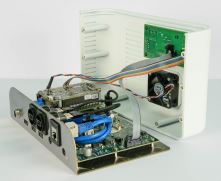3D Video Processing Unit
Description
The 3D Video Processing Unit (3D-VPU) generates a real-time 3D stereoscopic display by combining the signals from two standard 2D video cameras to generate a video output that displays as a 3D image on stereoscopic displays such as computer monitors equipped with an Xpol passive polarization screen or any HDMI 1.4a 3D television set.
For any application that uses the video display to provide operator feedback (e.g., heads-up dentistry, ophthalmic or endoscopic surgery) it is important to minimize the delay between the camera input and the display output to avoid creating hand-eye coordination problems. The 3D-VPU minimizes this delay by performing the video processing using streamlined and optimized logic pipelines implemented in a Field Programmable Gate Array (FPGA).
The use of an FPGA improves speed, reduces hardware complexity, and provides design flexibility that allows the unit to be customized without any changes to the hardware.
The 3D-VPU can be configured to use standard HD (720p) or Full-HD (1080p) cameras. It does not require the use of expensive synchronized cameras.
The standard 3D-VPU configuration accepts two HD (720p60) video inputs and provides three video outputs:
- 1080p60 row-interlaced 3D stereoscopic video for use with a monitor equipped with an Xpol passive polarization screen.
- 720p60 HDMI 1.4a 3D video for use with any 3D television set.
- 720p60 2D video for use with a standard 2D monitor or video recorder.
Other custom configurations can be implemented if desired.
Typical Application
The 3D-VPU is typically used to provide a "heads-up" display for stereo microscopes. This is done by replacing the standard stereo eyepiece unit on the microscope with a dual-camera unit such as the one produced by Design & Test Technology, then connecting the 3D-VPU to the cameras and to one or more display devices. The advantages of using this "heads-up" configuration are:
- It does not require the user to maintain a rigid position relative to the microscope eyepieces. This allows the user to maintain an upright posture, minimizing fatigue.
- It allows the microscope image to be seen by multiple viewers, especially if the secondary 3D output is used to drive a large screen television. This allows a standard 3D microscope to be used in a teaching environment without requiring the use of an expensive multiple eyepiece microscope system.
Download this information [PDF]


